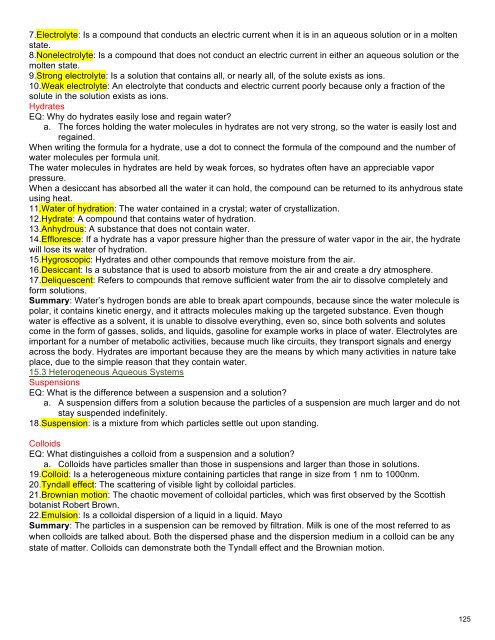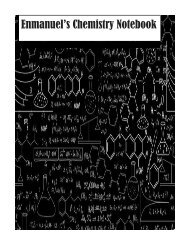Create successful ePaper yourself
Turn your PDF publications into a flip-book with our unique Google optimized e-Paper software.
7.Electrolyte: Is a compound that conducts an electric current when it is in an aqueous solution or in a molten<br />
state.<br />
8.Nonelectrolyte: Is a compound that does not conduct an electric current in either an aqueous solution or the<br />
molten state.<br />
9.Strong electrolyte: Is a solution that contains all, or nearly all, of the solute exists as ions.<br />
10.Weak electrolyte: An electrolyte that conducts and electric current poorly because only a fraction of the<br />
solute in the solution exists as ions.<br />
Hydrates<br />
EQ: Why do hydrates easily lose and regain water?<br />
a. The forces holding the water molecules in hydrates are not very strong, so the water is easily lost and<br />
regained.<br />
When writing the formula for a hydrate, use a dot to connect the formula of the compound and the number of<br />
water molecules per formula unit.<br />
The water molecules in hydrates are held by weak forces, so hydrates often have an appreciable vapor<br />
pressure.<br />
When a desiccant has absorbed all the water it can hold, the compound can be returned to its anhydrous state<br />
using heat.<br />
11.Water of hydration: The water contained in a crystal; water of crystallization.<br />
12.Hydrate: A compound that contains water of hydration.<br />
13.Anhydrous: A substance that does not contain water.<br />
14.Effloresce: If a hydrate has a vapor pressure higher than the pressure of water vapor in the air, the hydrate<br />
will lose its water of hydration.<br />
15.Hygroscopic: Hydrates and other compounds that remove moisture from the air.<br />
16.Desiccant: Is a substance that is used to absorb moisture from the air and create a dry atmosphere.<br />
17.Deliquescent: Refers to compounds that remove sufficient water from the air to dissolve completely and<br />
form solutions.<br />
Summary: Water’s hydrogen bonds are able to break apart compounds, because since the water molecule is<br />
polar, it contains kinetic energy, and it attracts molecules making up the targeted substance. Even though<br />
water is effective as a solvent, it is unable to dissolve everything, even so, since both solvents and solutes<br />
come in the form of gasses, solids, and liquids, gasoline for example works in place of water. Electrolytes are<br />
important for a number of metabolic activities, because much like circuits, they transport signals and energy<br />
across the body. Hydrates are important because they are the means by which many activities in nature take<br />
place, due to the simple reason that they contain water.<br />
15.3 Heterogeneous Aqueous Systems<br />
Suspensions<br />
EQ: What is the difference between a suspension and a solution?<br />
a. A suspension differs from a solution because the particles of a suspension are much larger and do not<br />
stay suspended indefinitely.<br />
18.Suspension: is a mixture from which particles settle out upon standing.<br />
Colloids<br />
EQ: What distinguishes a colloid from a suspension and a solution?<br />
a. Colloids have particles smaller than those in suspensions and larger than those in solutions.<br />
19.Colloid: Is a heterogeneous mixture containing particles that range in size from 1 nm to 1000nm.<br />
20.Tyndall effect: The scattering of visible light by colloidal particles.<br />
21.Brownian motion: The chaotic movement of colloidal particles, which was first observed by the Scottish<br />
botanist Robert Brown.<br />
22.Emulsion: Is a colloidal dispersion of a liquid in a liquid. Mayo<br />
Summary: The particles in a suspension can be removed by filtration. Milk is one of the most referred to as<br />
when colloids are talked about. Both the dispersed phase and the dispersion medium in a colloid can be any<br />
state of matter. Colloids can demonstrate both the Tyndall effect and the Brownian motion.




